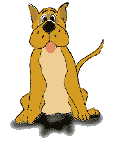

Cute... or a very bad idea?

1. Be Aware
No child, under the age of 8, should ever be left alone with any dog, ever. Kids receive 70% of all reported dog bites every year and, the majority of those, come from a known dog. Why? Because kids do stuff dogs don't like. Whether intentional or unintentional, kids sometimes hurt dogs or push them too far. In addition, a child is not usually taught how to recognize the warning signs the dog posts. Be especially vigilant when other kids are visiting, as they may not be as dog educated as your own children. Many bites occur when a neighbor child teases or mistreats his host's dog. I don't think we have to remind anyone how unpleasant that would be for all concerned, including the dog... a true lose/lose situation.
2. Be Considerate of the Dog's Needs
Children should never be allowed to bother a dog when he or she is in their space or eating. Even dogs with very easy going temperaments, just like us humans, and for any number of reasons, can have an occasional bad day. Make sure every member of the household, including yourself, lets the dog have his special spot where he can feel safe, secure, and not be bothered... sort of like when you're in the bathroom and the kids are banning on the door with questions and demands... what you wouldn't give for a moments peace. A dog finds it just as aggravating as you do when this happens.
3. Teach by Example
Demonstrate respect for all animals and explain that they feel pain and can get cranky just like humans. A child sometimes looks at the family dog as just another toy or stuffed animal. Children are taught by example.
4. Educate your child
Teach them how to act around strange dogs and dogs in other people's homes. Teach them to ask permission before petting any dog outside of the family. Teach them the proper way to meet a strange dog. Teach them how to behave if a dog shows signs of aggression. Show them pictures of dogs exhibiting warning signs and explain that they should leave the dog alone when they see those signs. Explain that, should a dog or group of dogs become agitated and approach him or her, they need to freeze and "become a tree". Impress on them the importance of not running and why running is a bad choice. Above all, teach them that they should not tease, or otherwise torment, dogs that are fenced or restrained. If the dog becomes agitated, he may jump the fence or break the tie out. In most states, if a dog bites someone as a result of being teased or threatened, the owner and dog are absolved of responsibility. Make sure your child knows to stay out of neighbors' yards without permission. Many a child has been bitten when they climb a fence to enter someone else’s yard and discover a loose dog that will protect his turf.
5. Start early
You should start educating your child on dog safety as soon as they are old enough to grasp the concept. Even if you don't have a family dog at that time, your child will inevitably encounter dogs when they visit friends or are just outside playing in the neighborhood
No child, under the age of 8, should ever be left alone with any dog, ever. Kids receive 70% of all reported dog bites every year and, the majority of those, come from a known dog. Why? Because kids do stuff dogs don't like. Whether intentional or unintentional, kids sometimes hurt dogs or push them too far. In addition, a child is not usually taught how to recognize the warning signs the dog posts. Be especially vigilant when other kids are visiting, as they may not be as dog educated as your own children. Many bites occur when a neighbor child teases or mistreats his host's dog. I don't think we have to remind anyone how unpleasant that would be for all concerned, including the dog... a true lose/lose situation.
2. Be Considerate of the Dog's Needs
Children should never be allowed to bother a dog when he or she is in their space or eating. Even dogs with very easy going temperaments, just like us humans, and for any number of reasons, can have an occasional bad day. Make sure every member of the household, including yourself, lets the dog have his special spot where he can feel safe, secure, and not be bothered... sort of like when you're in the bathroom and the kids are banning on the door with questions and demands... what you wouldn't give for a moments peace. A dog finds it just as aggravating as you do when this happens.
3. Teach by Example
Demonstrate respect for all animals and explain that they feel pain and can get cranky just like humans. A child sometimes looks at the family dog as just another toy or stuffed animal. Children are taught by example.
4. Educate your child
Teach them how to act around strange dogs and dogs in other people's homes. Teach them to ask permission before petting any dog outside of the family. Teach them the proper way to meet a strange dog. Teach them how to behave if a dog shows signs of aggression. Show them pictures of dogs exhibiting warning signs and explain that they should leave the dog alone when they see those signs. Explain that, should a dog or group of dogs become agitated and approach him or her, they need to freeze and "become a tree". Impress on them the importance of not running and why running is a bad choice. Above all, teach them that they should not tease, or otherwise torment, dogs that are fenced or restrained. If the dog becomes agitated, he may jump the fence or break the tie out. In most states, if a dog bites someone as a result of being teased or threatened, the owner and dog are absolved of responsibility. Make sure your child knows to stay out of neighbors' yards without permission. Many a child has been bitten when they climb a fence to enter someone else’s yard and discover a loose dog that will protect his turf.
5. Start early
You should start educating your child on dog safety as soon as they are old enough to grasp the concept. Even if you don't have a family dog at that time, your child will inevitably encounter dogs when they visit friends or are just outside playing in the neighborhood
Below are links to coloring pages you can print (right click on the image and choose print). Please take the time to have a fun coloring session with your child while you discuss the content. A few minutes invested now could save a lot of heartache later. BE PROACTIVE!
The slide show is a 5 minute presentation on recongnizing some of the more subtle signs a dog exhibits when they don't want to be bothered.
The slide show is a 5 minute presentation on recongnizing some of the more subtle signs a dog exhibits when they don't want to be bothered.
A very bad idea. Regardless of how mild a dog's temperament may be, he or she can always be having a bad day due to pain or other influences. A child this young would have no way of picking up on any of the body language signs that would indicate a problem, even the obvious ones like growling. Whoever took the picture is too far away to prevent an incident that can happen in a fraction of a second. Although the child is being watched now, he is learning that it's okay to remove food from the dog's bowl while he is eating and he will eventually do the same thing when not supervised. You wouldn't want your dog helping himself to food off your dinner plate and your dog doesn't like someone reaching into his dinner plate either. This is NOT the way to assert human dominance and food ownership. You can do that by hand feeding the dog once in a while.
K-9 Buddies, Inc.
© 2007-2011 K9 Buddies, Inc. All rights reserved